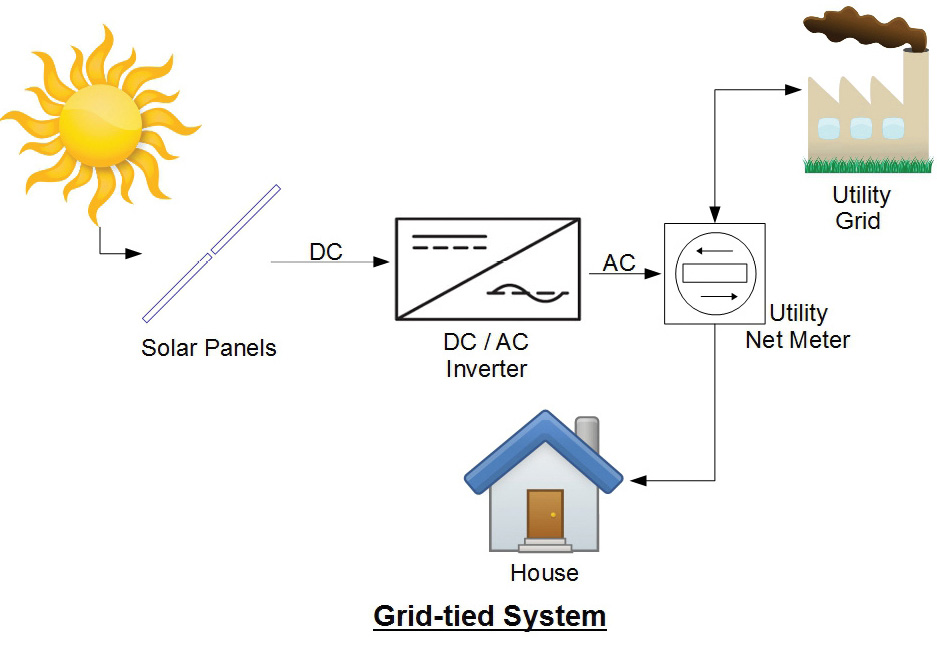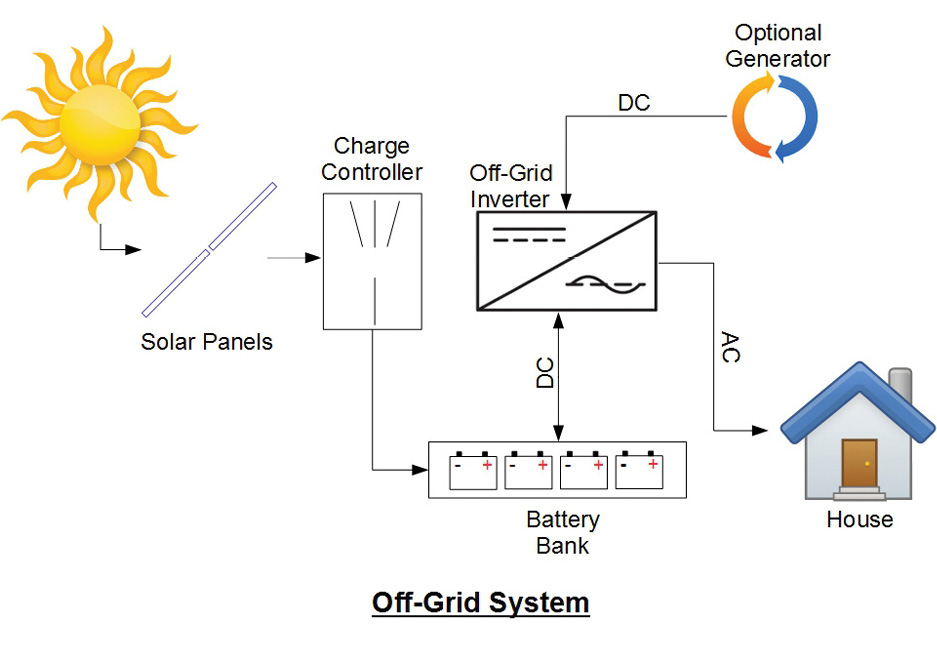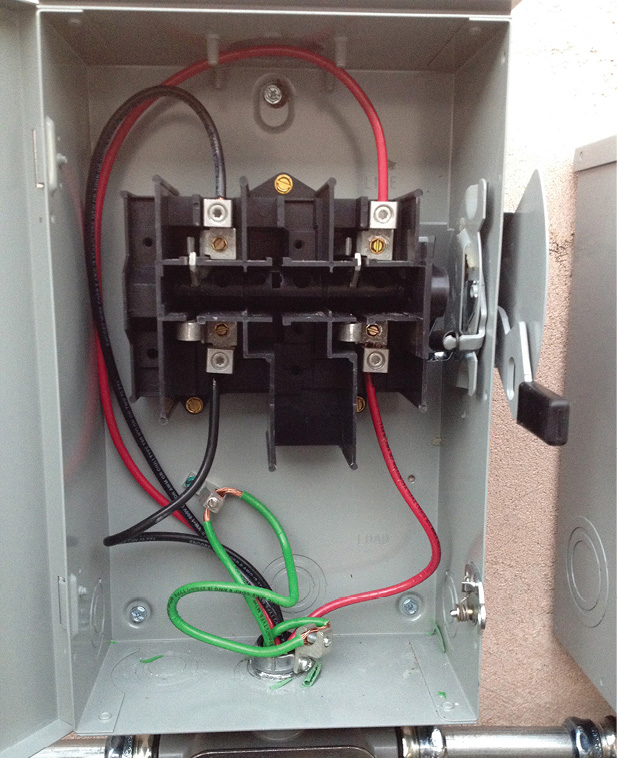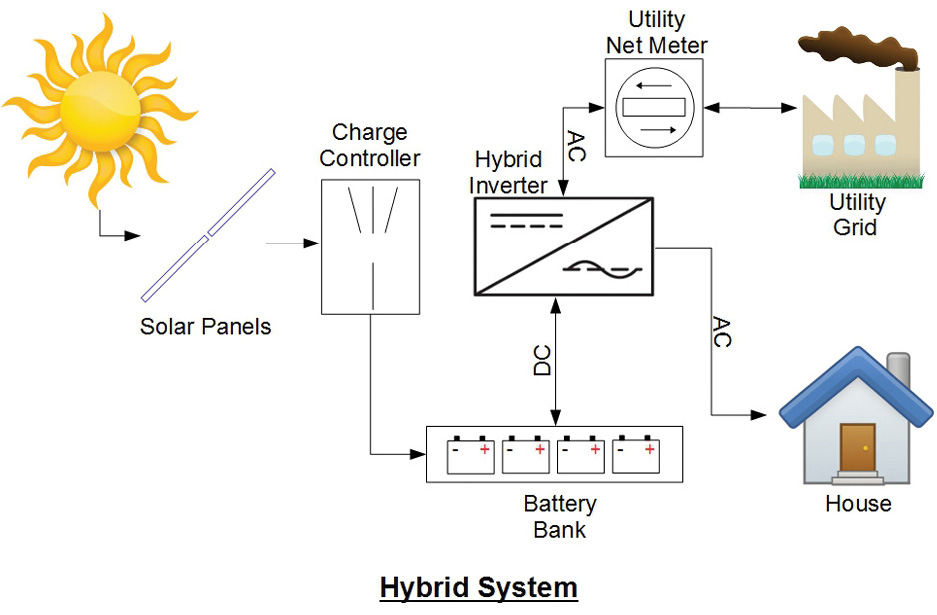

Once you have a general understanding of how the solar-energy system functions, choosing the right parts will be easier. It’s not complicated. I’ll now describe the parts of a standard grid tie, or “on-grid PV system.” We’ll also look briefly at what is known as an “off-grid PV system,” and I’ll explain the differences between the on-grid and off-grid systems and the normal conditions and criteria for selecting a system.
First, let’s look at the components of the grid-tied or on-grid system so that you know what you need to buy and what to plan for. Then I’ll review some of the options available for the various component parts. I’ll show you how to determine the size of the system you want and the positioning and layout of the panels, as well as the factors you’ll want to consider for the mounting framework that will attach the panels to your roof. We’ll also discuss some installation details that will complement the step-by-step photographic installation procedures illustrated and explained in Chapter 10. Lastly, I’ll review some financial assistance possibilities that may be available to you.
Basically, an on-grid PV system involves staying connected to the power grid. This means you’ll still receive power from the utility company when you need it, and in many areas you’ll be able to sell your excess power back to the utility under a simple registered agreement. Selling the excess power back will involve the installation of a net metering system that tracks and records how much credit you receive for the excess power your system feeds back into the grid.
An off-grid PV system is a solar electric generating system that is usually relatively small and is not connected to the utility grid. There can be many reasons for installing an off-grid PV system. It might be that the location of the system is not anywhere close to the nearest grid connection. The off-grid system might be used for a remote cabin, a small ranch, a hunting lodge, or for a remote research station or microwave station. Usually an off-grid PV system will include a battery storage subsystem, as there will be no power available from the grid for energy requirements after dark or in bad weather.
What are the benefits of grid-connected solar panels versus living off the grid? Deciding whether or not to grid-tie your solar array is usually pretty straightforward. The clear-cut benefits of being grid-tied appeal to most homeowners. There are, however, some who choose to live off-grid.
Let’s take a closer look at the benefits and downsides of grid-tied, off-grid, and hybrid connection solar systems.
Grid-tied, on-grid, utility-interactive, grid inter-tie, and grid back-feeding are all terms used to describe the same concept: a solar PV system that is connected to the utility power grid.
One advantage of grid-tying is that compared to the other two basic connection types, a grid connection will allow you to save more money with your solar PV array through lower rates granted by the utility company, net metering, and lower equipment and installation costs. For a fully functional off-grid solar system, batteries and other stand-alone equipment are required, and these will add to both the initial cost of the system as well as maintenance costs down the road. Grid-tied solar systems are therefore generally cheaper and simpler to install, as long as the grid is reasonably close to your home.

A schematic of a “grid-tied” solar system.
On bright days, your solar panels will usually generate more electricity than you will consume during the daylight hours. With net metering, homeowners can put this excess electricity onto the utility grid rather than store it themselves in a battery-bank storage system, which would involve a considerably larger initial investment.
Net metering (called a “feed-in tariff” scheme in many countries) has played a very important role in how solar power has been supported by governments to incentivize new buyers. Without it, residential solar systems are much less financially feasible. With net metering, most utility companies are required to buy electricity from homeowners at the same rate as they sell it themselves. In this way, the utility grid acts as a huge virtual battery system.
Let me explain this battery concept. Electricity has to be spent in real time. However, it can be temporarily stored as other forms of energy (e.g. chemical energy in batteries), though storage involves significant losses. The electric power grid also works like a battery, but without the need for maintenance or replacements and with much higher efficiency. In other words, more electricity and more money goes to waste with conventional battery systems compared to grid-tied systems.
Annual US electricity transmission and distribution losses average about 7 percent of the electricity transmitted, according to the Energy Information Administration (EIA) data. Lead-acid batteries, which are commonly used with solar panels, are only about 80-85 percent efficient at storing energy, and their performance degrades over time depending on factors like rate of discharge and the degree of discharge, or “DOD.” The DOD is the minimum charge level at which point your PV system stops draining the battery and starts the recharge cycle again. The battery “charge controller” manages this DOD cut-off level. This DOD control system is used to protect the battery or battery bank because if you drain the batteries too much it will reduce their useful life.
Additional perks of being grid-tied include access to backup power from the utility grid in case your solar system stops generating electricity for one reason or another. At the same time, you’ll also help to mitigate the utility company’s peak load. As a result, the overall efficiency of the electrical grid system is improved.
There are a few key differences between the equipment needed for grid-tied, off-grid, and hybrid PV solar systems. In addition to the PV panels, mounting support system hardware, and other standard items like DC and AC disconnect switches, grid-tied solar systems rely on grid-tie inverters (GTI) or micro-inverters, and power meters (net metering type).
What’s the job of PV solar system inverters? They regulate the voltage and convert the direct current (DC) received from your solar panels. The direct current generated by your solar panel array is converted by a central inverter or by many micro-inverters into alternating current (AC), which is the type of current utilized by the electrical appliances in your home. It might be noted here that it’s now possible in some areas to purchase DC appliances. In addition, grid-tied inverters, also known as grid-interactive or synchronous inverters, synchronize the phase and frequency of the current to fit the utility grid, nominally 60Hz. The output voltage is also adjusted slightly higher than the grid voltage, in order for excess electricity to flow outwards to the grid.
Most homeowners will need to replace their current power meter with one designed for net metering. This device, often called a net meter or a two-way meter, is capable of measuring power going in both directions, from the grid to your house and vice versa. You should consult with your local utility company and see what net metering options you have. In some places, the utility company will issue a power meter for free, and they’ll pay full price for the electricity you generate and deliver to the grid (the same price $/kWh as they charge you). However, this is not always the case.
An off-grid solar system is the obvious alternative to a grid-tied system. For homeowners with access to the grid, off-grid solar systems are usually not preferred because in order to ensure access to electricity at all times, off-grid solar systems require battery storage and a backup generator. On top of this, a battery bank typically needs to be replaced after ten years. Batteries are complex, they involve a high initial cost with respect to the overall system, and they also slightly decrease overall system efficiency. However, an off-grid system can provide a viable solution in the case that you have no access (or very difficult access) to the utility grid. This type of system can be cheaper than extending power lines in most remote areas, so you might consider an off-grid system if your location is more than 200 yards from the grid. The cost for new overhead transmission lines start at around $174,000 per mile ($108,000 per Km) for rural construction, and they can run into the millions of dollars per mile for urban construction.

A schematic of an “off-grid” solar system.
Off-grid systems also provide a solution for those who want to be energy independent. To many, the idea of living off the grid and being self-sufficient just feels good. For some people, this feeling is worth more than saving money. Energy self-sufficiency is also a form of security. Local or regional power failures in the utility grid do not affect off-grid PV solar systems. On the other hand, batteries can only store a limited amount of energy, and during cloudy times, sometimes security actually lies in being connected to the grid. To manage this risk, you might be wise to consider installing a backup diesel-fuel electric generator to be prepared for extended periods of rainy and cloudy weather.
Typical off-grid solar systems require the following extra components in addition to the PV solar modules and mounting support framework hardware:
• Solar Charge Controller
• Battery Bank
• DC and AC Disconnect Switches
• Off-Grid Central Inverter or Micro-Inverters
• Backup Generator (optional but recommended)
Solar charge controllers are also known as charge regulators or battery regulators. The last term is probably the best for describing what this device actually does: Solar battery charger controllers limit the rate of current being delivered to the battery storage bank and protect the batteries from overcharging. Good charge controllers are crucial for keeping batteries healthy and ensuring that the lifetime of a battery bank is maximized. If you have a battery-based inverter, chances are the charge controller is integrated into the inverter.

A “battery bank” of 10 batteries.
Without a battery bank or a backup generator, an off-grid system will mean “lights out” at sunset. A battery bank is essentially a group of batteries wired together, connected to the inverter with a DC disconnect switch, and then connected to selected wire circuits to provide power after dark to certain lights, as well as to selected electrical outlets for appliances like a television, computer, or refrigerator. LED lights will help extend the power provided before the battery bank runs out of energy.
The above photos illustrate the diversity and flexibility of PV solar battery bank systems:
A DC disconnect switch, a meter, and an AC disconnect switch.

A different DC disconnect switch.

The inside view of a DC disconnect switch.
The beauty of solar battery banks is they’re completely modular, which enables the homeowner to expand the energy storage system whenever desired. Depending on proper maintenance, frequency of use, and “depth of discharge,” the solar batteries will be serviceable for up to ten years before they’ll need to be replaced. We go into more details about battery systems and back-up generators in Chapter 3.
AC and DC safety disconnects are required for all solar systems. For off-grid solar systems, one additional DC disconnect is installed between the battery bank and the off-grid inverter. It’s used to switch off the current flowing between these components. This is important for maintenance, troubleshooting, and protection against electrical fires.
There’s no need for an inverter if you’re only setting up solar panels for your boat or your RV, or for electric loads that use only direct current. However, you’ll need an inverter to convert DC to AC for all other standard electrical appliances in your home. Off-grid inverters do not have to match phase with the utility sine wave as opposed to grid-tied inverters. Therefore, you can expect a given manufacturer’s off-grid converter to be technically simpler and slightly more economical than its grid-tied counterpart. Electrical current flows from the solar panels through the solar charge controller and the battery bank before it’s finally converted into AC by the off-grid inverter.

A metering device with a DC disconnect switch.
It takes a lot of money and big batteries to prepare for several consecutive days without the sun shining or access to the grid. This is where backup diesel generators can play a key role. In most cases, installing a backup generator that runs on diesel is a better choice than investing in an oversized battery bank that seldom gets to operate at full potential. Backup generators will normally run on propane, petroleum (diesel), or gasoline. Backup generators typically produce an AC output, which can be sent through the inverter for direct use or can be converted into DC for battery storage.
Hybrid solar systems combine the best elements from both grid-tied and off-grid solar systems. These systems can either be described as off-grid solar with utility backup power, or grid-tied solar with backup battery storage. If you own a grid-tied solar system and drive a vehicle that runs on electricity, you already have something similar to a hybrid system. In essence, electric vehicles are battery systems on four wheels.
A hybrid solar system is a grid-tied system with backup energy storage that incorporates a battery bank. Hybrid solar systems are less expensive than off-grid solar systems. Often you don’t really need a backup generator, and the capacity of your battery bank can be downsized. Off-peak electricity from the utility company is cheaper than using a backup diesel generator. Also, the noise of a generator motor may be an issue to consider.

A typical hybrid connection solar system often simply referred to as a “hybrid solar system.”
Hybrid solar systems utilize battery-based grid-tie inverters. Combining these devices can draw electrical power to and from battery banks, as well as synchronize with the utility grid. The new inverters let homeowners take advantage of changes in the utility electricity rates throughout the day. Solar panels usually output the most electrical power around noon, just before the time when the price of electricity peaks. Your home can be programmed to consume power during off-peak hours by appropriately programming your rooftop PV solar system. Consequently, you can temporarily store excess electricity from your PV solar panels in your battery storage system, and then automatically feed it into the utility grid at a time when you will be paid the most for every kWh.
Smart solar holds a lot of promise, as the introduction of hybrid solar systems has opened up opportunities for many interesting innovations. The concept will become increasingly important as we transition towards the so-called “smart grid” in the coming years.
But for now, the vast majority of homeowners who have a solar energy system find that tapping the utility grid for electricity while also using the grid for energy storage is significantly cheaper and more practical than using hybrid systems with battery banks and backup generators. Complete independence from the grid system may be attractive to many on principle, but it increases the cost of the initial investment substantially. Therefore, this option is usually discarded in favor of a simple grid-tied solar system.
Of course, where the home or weekend cottage is in a remote location without access to the grid or where the cost of installing a line is prohibitive, owners might gladly pay for the extra cost of a battery storage system, and maybe also a generator.